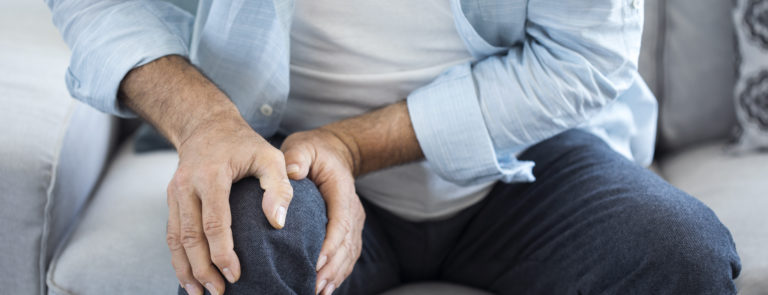10% off £35
Code:SAVE
What causes swollen feet and ankles?

Most people will experience swollen feet and ankles in their lifetime. But what can you do to get rid of them when they appear?
Summary
1What is oedema?
‘Oedema’ is the term doctors use to describe swelling from excess fluid in body tissues. It occurs when something disrupts the fluid in our body...
2Oedema causes
There are a variety of factors that can contribute to swollen feet and ankles, ranging from mild to severe. Here are some of the most common causes...
3Swollen foot and ankle treatment
At H&B, our range of water retention tablets can help ease symptoms of mild oedema and are especially effective when used alongside the following...
Several things can cause your feet and ankles to become swollen and uncomfortable. Injuries or inflammation, water retention due to a medical condition, or simply sitting still for too long can all cause swollen feet and ankles.1
Swollen feet and ankles are very common – especially among older adults – and typically occur when there’s too much fluid in the body’s tissues.2 Medically known as oedema, this fluid build-up can affect any of your body’s tissues but is more likely to impact your lower legs and feet.3
If you have swelling or puffiness under the skin on your ankles and feet, tight skin with a shiny surface, or pitted or dimpled skin when you press on it for a few seconds, you likely have oedema.1,4
In this article, we’ll discuss swollen feet and ankles, examining what oedema is, its causes and the most effective treatments.
What is oedema?
‘Oedema’ is the term doctors use to describe swelling from excess fluid in body tissues.3
It occurs when something disrupts the fluid in our body that fills the spaces between blood vessels and cells.4,5,6 This fluid then expands and leaks into nearby tissues, causing them to swell. The effect of gravity causes the fluid to pool in the lower parts of the body, such as the lower legs, ankles, and feet.7
‘Peripheral oedema’ describes when this fluid build-up and swelling is in your lower legs or hands.4
Oedema causes
There are a variety of factors that can contribute to swollen feet and ankles, ranging from mild to severe.
Here are some of the most common causes:
- standing or sitting for too long: sitting or standing in the same position over long periods can result in leg swelling. That’s why travelling long distances or sitting on a flight can lead to swelling and discomfort8
- excessive salt: consuming too much salt as part of your diet can cause your body to retain water. This can then leak into your tissues, resulting in swelling9
- excess weight: carrying a little more body weight can put extra pressure on your veins, leading to fluid build-up and oedema.10 Excess weight can also affect your lymphatic system (the system that helps control your body’s fluids) and cause long-term inflammation, which can both contribute to the development of oedema.11,12 It may also increase your risk for other conditions that cause oedema, such as sleep disorders and heart problems4
- hormonal changes: you might notice that your feet swell around the same time each month. This is because hormone changes during the menstrual cycle can result in water retention, causing swollen feet and ankles13
- pregnancy: during pregnancy, your body will hold more water than usual. The pressure from your growing uterus and the extra water in the body can result in swollen legs, ankles and feet14
- medications: many medications can cause oedema as a side effect, including some calcium channel blockers, corticosteroids, blood pressure medications and various painkillers15
- injury: swelling can also be your body’s response to injury. Sprains, strains or other injuries to the feet or ankles can trigger pain, bruising and swelling16
- insect bites or stings: bites and stings can cause inflammation and red, itchy marks to appear on the skin. The affected area can also become swollen due to an excessive build-up of fluid17
- underlying medical condition: sometimes, oedema is a symptom of a heart, kidney or liver condition4
Swollen foot and ankle treatment
Finding the right treatment for your swollen feet and ankles will depend on the cause.
However, mild cases of oedema will usually go away without treatment and, often, raising your legs on a chair higher than your heart or wearing compression stockings can help reduce swelling and discomfort.1,18
At H&B, our range of water retention tablets can also help ease symptoms of mild oedema and are especially effective when used alongside the following lifestyle modifications.
If you experience swelling due to a rolled, twisted, strained, or sprained ankle, you can try ‘PRICE’ (protection, rest, ice, compression, elevate) therapy for 48–72 hours after your injury to help reduce swelling. This involves:19,20,21
- protection – protect your ankle from further injury by using a support or supportive high-top shoes
- rest – avoid activity and putting weight on the injury
- ice – apply a bag of ice or frozen vegetables wrapped in a tea towel to your injury for up to 20 minutes every two or three hours
- compression – use an elastic tubular bandage around the injury, snug but not tight, to support the injury and reduce the swelling. However, don’t wear it while sleeping
- elevate – raise the affected ankle and support it on a pillow to control swelling
Regular low-impact exercise, such as walking, cycling or swimming, not only encourages good blood circulation but also helps support the lymphatic system, reducing fluid build-up in your feet and ankles. The lymphatic system is a network of organs, vessels and tissues that balance your levels of bodily fluids and protect the body from infection.1,4,22
Aiming for 30 minutes of exercise on most days of the week is a great way to improve your heart health and manage your likelihood of oedema.23
Sodium, or salt, helps regulate your blood pressure and fluid levels – but only in small doses!24
If you regularly consume too much salt, your body retains water, which may cause your feet to swell. Reducing your salt intake may help reduce this level of water retention, preventing swollen feet and ankles.1,9
Potassium can also help regulate your fluid levels and can counteract the effects of excess sodium. So, it’s essential to get enough of it.25,26
Some of the best potassium-rich foods include:27
- fruit, such as apricots, raisins, prunes and bananas
- vegetables, such as potatoes, butternut squash, spinach and tomatoes
- lentils, kidney beans and nuts
- milk and yoghurt
- meat, chicken and fish
- legumes, nuts and seeds
- whole grains
- green leafy vegetables, such as spinach
- milk and yoghurt
It’s worth noting that too much potassium can be harmful in older people and those with kidney disorders. This is because your kidneys become less able to remove potassium from the blood as you get older. It’s important to check with your GP before taking new supplements including any over-the-counter potassium supplements.31
If you experience a build-up of fluid from carrying excess weight, your GP may advise making some lifestyle changes to lose weight.1,32
Often, getting active for short sessions every day, aiming to eat a varied diet that includes 30 different plants a week, and cutting down on food that’s high in fat and sugar can help you move towards a healthy weight. You only need to make small changes and try one thing at a time to see what works best for you.33,34
As counterintuitive as it may sound, drinking more water could actually help prevent water retention and reduce your swelling.35
Being dehydrated causes our bodies to retain extra water to help compensate for the lack of water intake. Drinking water helps our body flush out any excess water and sodium in our urine.36
If an underlying medical condition is causing your swelling, your GP will be able to advise you on the most suitable treatment plan.
If your prescribed medication is causing ankle and foot swelling, they can also recommend the best course of action. However, you should never stop taking prescribed medication unless recommended by your GP.
It’s also crucial to consult your GP if you have persistent or severe swelling in your feet and ankles. They’ll be able to examine your swollen feet and personalise your treatment around your specific needs.1,35
The final say
While swollen feet and ankles may be uncomfortable, they can often improve without treatment or are easy to manage through various dietary and lifestyle changes.
By understanding the causes of oedema and implementing strategies to manage them, you can reduce your swelling, enhance circulation and improve your overall quality of life.
Remember to prioritise self-care at the same time, staying active and seeking medical advice if you have any underlying health concerns or medications that could be causing your oedema.
The advice in this article is for information only and should not replace medical care. Please check with your GP or healthcare professional before trying any supplements, treatments or remedies. Food supplements must not be used as a substitute for a varied and balanced diet, and a healthy lifestyle.
- In brief: Causes and signs of edema [Internet]. Nih.gov. Institute for Quality and Efficiency in Health Care (IQWiG); 2022 [cited 2024 May 28]. Available from: https://www.ncbi.nlm.nih.gov/books/NBK279409/
- Besharat, S., et al. Peripheral edema: A common and persistent health problem for older Americans. PLOS ONE. 2021;16(12):e0260742. https://doi.org/10.1371/journal.pone.0260742.
- Lent-Schochet, D., et al. Physiology, edema [Internet]. StatPearls Publishing; 2023. Available from: https://www.ncbi.nlm.nih.gov/books/NBK537065.
- Goyal, A., et al. Peripheral edema [Internet]. StatPearls Publishing; 2023. Available from: https://www.ncbi.nlm.nih.gov/books/NBK554452.
- Brinkman, JE., et al. Physiology, body fluids [Internet]. StatPearls Publishing; 2023. Available from: https://www.ncbi.nlm.nih.gov/books/NBK482447.
- Stewart, RH. A modern view of the interstitial space in health and disease. Frontiers in Veterinary Science. 2020;7. https://doi.org/10.3389/fvets.2020.609583.
- Baish, JW., et al. The effects of gravity and compression on interstitial fluid transport in the lower limb. Scientific Reports. 2022;12(1). https://doi.org/10.1038/s41598-022-09028-9.
- Francisco, R., et al. Breaking of sitting time prevents lower leg swelling — comparison among sit, stand and intermittent (sit-to-stand transitions) conditions. Biology. 2022;11(6):899. https://doi.org/10.3390/biology11060899.
- Yoshikawa M, Kazumasa Torimoto, Hirayama A, Keisuke Kiba, Yamamoto Y, Akashi Y, et al. Daily salt intake is associated with leg edema and nocturnal urinary volume in elderly men. Neurourology and urodynamics [Internet]. 2020 May 27 [cited 2024 May 28];39(5):1550–6. Available from: https://onlinelibrary.wiley.com/doi/10.1002/nau.24401
- Darlenski, R., et al. The link between obesity and the skin. Frontiers in Nutrition. 2022;9. https://doi.org/10.3389/fnut.2022.855573.
- Kataru, RP., et al. Regulation of lymphatic function in obesity. Frontiers in Physiology. 2020;11. https://doi.org/10.3389/fphys.2020.00459.
- Ellulu, MS., et al. Obesity and inflammation: The linking mechanism and the complications. Archives of Medical Science. 2017;13(4):851–63. Available from: https://www.ncbi.nlm.nih.gov/pmc/articles/PMC5507106.
- Tacani, P., et al. Characterization of symptoms and edema distribution in premenstrual syndrome. International Journal of Women’s Health. 2015;297. https://doi.org/10.2147/IJWH.S74251.
- NHS. Swollen ankles, feet and fingers in pregnancy [Internet]. [cited 2024 Mar 26]. Available from: https://www.nhs.uk/pregnancy/related-conditions/common-symptoms/swollen-ankles-feet-and-fingers
- Largeau, B., et al. Drug‐induced peripheral oedema: An aetiology‐based review. British Journal of Clinical Pharmacology. 2021;87(8):3043–55. https://doi.org/10.1111/bcp.14752.
- Chen, L., et al. Inflammatory responses and inflammation-associated diseases in organs. Oncotarget. 2017;9(6):7204–18. https://doi.org/10.18632/oncotarget.23208.
- Powers, J., et al. Insect bites [Internet]. StatPearls Publishing; 2023 [cited 2024 Mar 18]. Available from: https://www.ncbi.nlm.nih.gov/books/NBK537235.
- Olsen, JHH., et al. The effect of compression stocking on leg edema and discomfort during a 3-hour flight: A randomized controlled trial. European Journal of Internal Medicine. 2019;62:54–7. https://doi.org/10.1016/j.ejim.2019.01.013.
- NHS. Sprains and strains [Internet]. [cited 2024 Mar 18]. Available from: https://www.nhs.uk/conditions/sprains-and-strains.
- NICE. Sprains and strains: Scenario: Management [Internet]. [cited 2024 Mar 18]. Available from: https://cks.nice.org.uk/topics/sprains-strains/management/management.
- Bleakley CM, Seán O'Connor, Tully MA, Rocke LG, MacAuley DC, McDonough SM. The PRICE study (Protection Rest Ice Compression Elevation): design of a randomised controlled trial comparing standard versus cryokinetic ice applications in the management of acute ankle sprain [ISRCTN13903946]. BMC musculoskeletal disorders [Internet]. 2007 Dec 1 [cited 2024 May 28];8(1). Available from: https://www.ncbi.nlm.nih.gov/pmc/articles/PMC2228299/
- Fu, MR., et al. The effects of exercise-based interventions on fluid overload symptoms in patients with heart failure: A systematic review and meta-analysis. Biomedicines. 2022;10(5):1111. https://doi.org/10.3390/biomedicines10051111.
- NHS. Physical activity guidelines for adults aged 19 to 64 [Internet]. [cited 2024 Mar 18]. Available from: https://www.nhs.uk/live-well/exercise/physical-activity-guidelines-for-adults-aged-19-to-64.
- NHS Choices. Salt in your diet [Internet]. 2024 [cited 2024 May 28]. Available from: https://www.nhs.uk/live-well/eat-well/food-types/salt-in-your-diet/
- How the body regulates salt levels [Internet]. National Institutes of Health (NIH). 2017 [cited 2024 May 28]. Available from: https://www.nih.gov/news-events/nih-research-matters/how-body-regulates-salt-levels
- Shrimanker I;Bhattarai S. Electrolytes [Internet]. 2023 [cited 2024 May 28]. Available from: https://pubmed.ncbi.nlm.nih.gov/31082167/
- Office of Dietary Supplements. Potassium: Fact sheet for consumers [Internet]. [cited 2024 Mar 18]. Available from: https://ods.od.nih.gov/factsheets/Potassium-Consumer.
- Ebrahimi, E., et al. Effects of magnesium and vitamin B6 on the severity of premenstrual syndrome symptoms. Journal of Caring Sciences. 2012(4):183–9. Available from: https://www.ncbi.nlm.nih.gov/pmc/articles/PMC4161081.
- Kaya M, Bulent Ahishali. The role of magnesium in edema and blood brain barrier disruption [Internet]. Nih.gov. University of Adelaide Press; 2022 [cited 2024 May 28]. Available from: https://www.ncbi.nlm.nih.gov/books/NBK507252/
- Office of Dietary Supplements. Magnesium Fact sheet for consumers [Internet]. [cited 2024 Mar 18]. Available from: https://ods.od.nih.gov/factsheets/Magnesium-Consumer.
- Yamada S, Inaba M. Potassium Metabolism and Management in Patients with CKD. Nutrients [Internet]. 2021 May 21 [cited 2024 May 28];13(6):1751–1. Available from: https://www.ncbi.nlm.nih.gov/pmc/articles/PMC8224083/
- West W, Brady-West D, West KP. A comparison of statistical associations between oedema in the lumbar fat on MRI, BMI and Back Fat Thickness (BFT). Heliyon [Internet]. 2018 Jan 1 [cited 2024 May 28];4(1):e00500–0. Available from: https://www.ncbi.nlm.nih.gov/pmc/articles/PMC5857512/
- Lipoedema [Internet]. NHS inform. 2023 [cited 2024 May 28]. Available from: https://www.nhsinform.scot/healthy-living/womens-health/middle-years-around-25-to-50-years/long-term-conditions/lipoedema/
- NHS. Tips to help you lose weight [Internet]. [cited 2024 Mar 26]. Available from: https://www.nhs.uk/live-well/healthy-weight/managing-your-weight/tips-to-help-you-lose-weight
- NHS. Swollen arms and hands (oedema). [cited 2024 Mar 26]. Available from: https://www.nhs.uk/conditions/swollen-arms-and-hands-oedema
- Bankir L, Perucca J, Norsk P, Bouby N, Damgaard M. Relationship between Sodium Intake and Water Intake: The False and the True. Annals of nutrition & metabolism [Internet]. 2017 Jan 1 [cited 2024 May 28];70(Suppl. 1):51–61. Available from: https://pubmed.ncbi.nlm.nih.gov/28614828/
Related Articles
Shop by wellness goal
Sign up for exclusive offers
Plus, get expert advice to support your health & wellness straight to your inbox when you sign up to Holland & Barrett emails.
Read our
privacy policy














